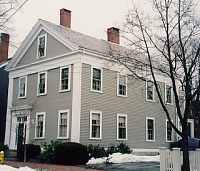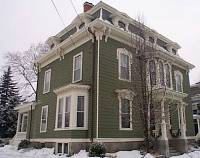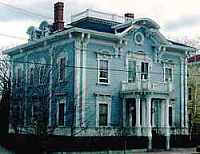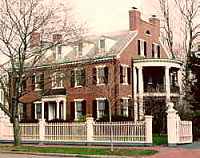Architecture in the 19th and 20th Centuries
While Salem is best known for its First period and Federal architecture, equally outstanding buildings from later periods can be found in the Greek Revival, Queen Anne, Gothic Revival, Victorian Gothic, and Colonial Revival styles.

|
The Joseph Winn, Jr. House 1843
National Register of Historic Places
Private Home
The Greek Revival style is often called the "first truly American style". This style arose out of the young nation's desire to identify with the ideals and architecture of the ancient Greek Republic and was heightened by the Greek Revolution in 1821. This example was built for Joseph Winn, Jr., a wholesale shoe businessman and the former captain of the St. Paul, the largest Salem trading vessel of its era. |

|
The Francis Cox House 1846
National Register of Historic Places
Private Home
The Italianate style was inspired by the vernacular farmhouse architecture of the Italian country villas. The dwelling shown is one of Salem's earliest Italianate buildings. This style is most frequently identified by heavy wooden brackets or pendants. While few Salem houses exemplify the Italianate style, bracketing was commonly added to Georgian, Federal, and Greek Revival houses in an attempt to modernize them. |

|
The Leonard Harrington House 1871
National Register of Historic Places
Private Home
This Second Empire dwelling was built for Boston leather dealer Leonard Harrington, Jr. The "Second Empire" refers to the the reign of Emperor Napoleon III, when Mansart introduced the hallmark double-pitched roof in his design of the Louvre in France. This style is also sometimes referred to as the Mansard or French Academy style. |

|
The Putnam-Balch House 1871-1872
National Register of Historic Places
Private Home
This majestic Victorian eclectic mansion, known as "Greymoor", demonstrates the possibilities of wooden ornamentation in the immediate post-Civil war period. This building provides an "eclectic" mixture of the decorative details of the French Academic and Italianate styles. Other Victorian forms such as the "Stick" style are well represented in the Salem Willows area while examples of the Queen Anne Victorian style are scattered throughout the city. |

|
The Robert M. Mahoney House c. 1916-1917
Private Home
Architect A. G. Richardson borrowed the forms and features of Georgian Revival and Federal building in his design concepts for this handsome brick residence built for lawyer Robert M. Mahoney. The previous building on the site was swept away by the great Salem fire of 1914.
|
